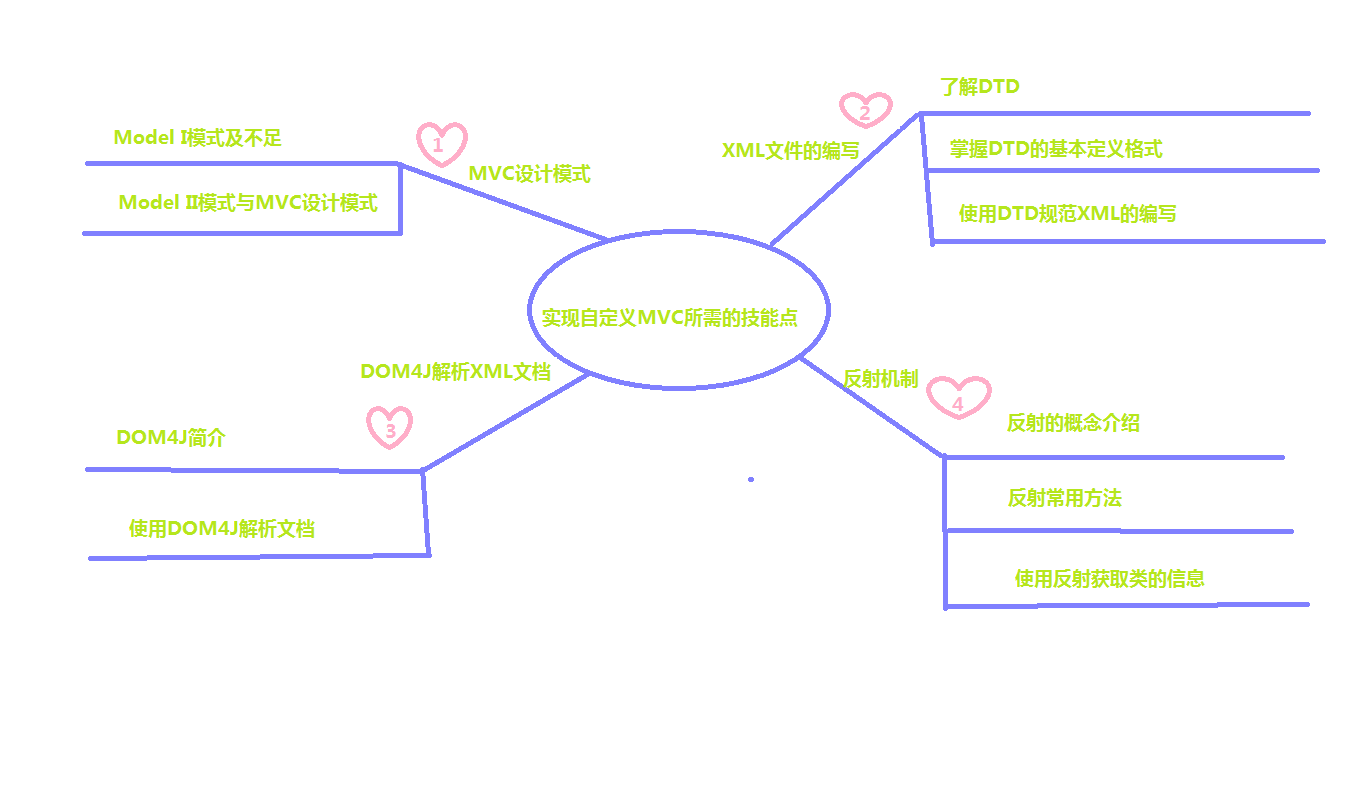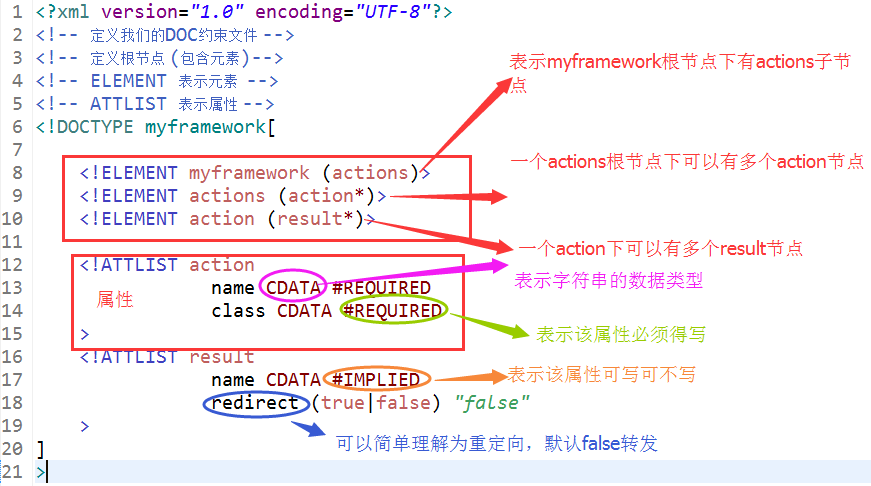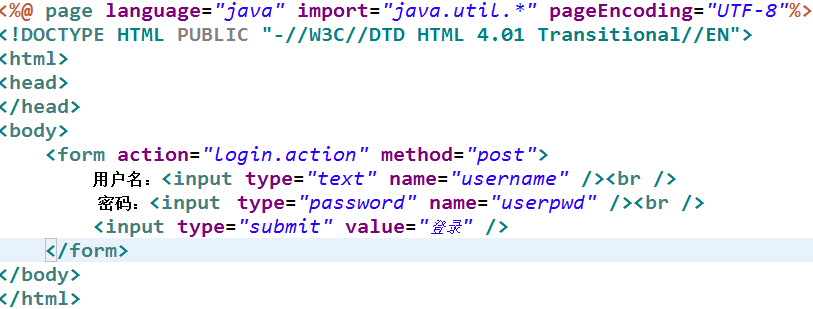- 实现自定义MVC的体系结构图

1、Model I模式开发Web应用时,分两种情况:
*纯JSP技术方式开发
*JSP+JavaBean方式开发
2、Model I模式开发的不足:
*JSP页面中嵌入大量的Java代码,可读性差。
*大量代码在JSP中难以复用。
*后期维护及扩展的难度大。
3、为了克服Model I模式的缺陷,引入了Model II的模式开发
*Model II模式体现了基于MVC(Model-View-Controller,模型-视图-控制器)的设计模式,简单的说,Model II模式就是将数据显示、流程控制和业务逻辑处理分离,使之相互独立。
4、MVC设计模式由3个部分组成各部分的作用。
*Model:模型,主要用于数据和业务的处理。
*View:视图,用于数据显示。
*Controller:控制器,用于流程控制。
5、MVC设计模式的特点
*一个模型可以对应多个视图。
*显示与逻辑控制分离。
*分层控制,减低了代码间的耦合。
- 我们如何创建一个自己的MVC框架??
(一)我们要在lib里面准备一个夹包
dom4j-1.6.1.jar 主要作用:解析xml文件
(二)准备配置文档(在src下)
<!DOCTYPE myframework[
<!ELEMENT myframework (actions) >
<!ELEMENT actions (action*)>
<!ELEMENT action (result*)>
<!ATTLIST action name CDATA #REQUIRED
class CDATA #REQUIRED
>
<!ATTLIST result name CDATA #IMPLIED
redirect (true|false) "false"
>
]>
解释:

解释:根据上述约束完成的“*”代表该节点可以出现多次
<myframework>
<actions>
<action name="LoginAction" class="cn.action.LoginAction">
<result name="success">success.jsp</result>
<result name="login">login.jsp</result>
</action>
</actions>
</myframework>
(三)自己准备一个Action接口,用于放入结果集和执行方法
package cn.framework;
import javax.servlet.http.HttpServletRequest;
import javax.servlet.http.HttpServletResponse;
public interface Action {
public final String SUCCESS = "success";
public final String ERROR = "error";
public final String LOGIN = "login";
public final String INPUT = "input";
public String execute(HttpServletRequest request,
HttpServletResponse response);
}
(四)定义一个ResultMapping用来存放result节点
package cn.framework;
public class ResultMapping {
//result节点名字
private String name;
//是否重定向
private boolean redirect;
//跳转的页面
private String url;
public ResultMapping() {
}
public ResultMapping(String name, boolean redirect, String url) {
this.name = name;
this.redirect = redirect;
this.url = url;
}
public String getName() {
return name;
}
public void setName(String name) {
this.name = name;
}
public boolean isRedirect() {
return redirect;
}
public void setRedirect(boolean redirect) {
this.redirect = redirect;
}
public String getUrl() {
return url;
}
public void setUrl(String url) {
this.url = url;
}
}
(五)定义一个ActionMapping用来存放Action节点
package cn.framework;
import java.util.HashMap;
import java.util.Map;
public class ActionMapping {
// Action名称
private String name;
// Action名称对应的Action的类的全称
private String className;
// result集合
private Map<String, ResultMapping> results = new HashMap<String, ResultMapping>();
public ActionMapping() {
}
public ActionMapping(String name, String className, Map<String, ResultMapping> results) {
super();
this.name = name;
this.className = className;
this.results = results;
}
public String getName() {
return name;
}
public void setName(String name) {
this.name = name;
}
public String getClassName() {
return className;
}
public void setClassName(String className) {
this.className = className;
}
public Map<String, ResultMapping> getResults() {
return results;
}
public void setResults(Map<String, ResultMapping> results) {
this.results = results;
}
}
(六)准备一个ActionMappingManager是用来管理ActionMapping的
package cn.framework;
import java.io.InputStream;
import java.util.HashMap;
import java.util.List;
import java.util.Map;
import org.dom4j.Attribute;
import org.dom4j.Document;
import org.dom4j.Element;
import org.dom4j.io.SAXReader;
public class ActionMappingManager {
Map<String, ActionMapping> actionMapping = new HashMap<String, ActionMapping>();
public ActionMappingManager() {
init();
}
public ActionMapping getActionMapping(String actionName) {
return actionMapping.get(actionName);
}
public ActionMappingManager(String fileName) {
}
public Map<String, ActionMapping> getActionMapping() {
return actionMapping;
}
public void setActionMapping(Map<String, ActionMapping> actionMapping) {
this.actionMapping = actionMapping;
}
public static void main(String[] args) {
new ActionMappingManager().init();
}
public void init() {
InputStream is = this.getClass().getResourceAsStream("/myframework.xml");
SAXReader sr = new SAXReader();
try {
Document doc = sr.read(is);
Element elRoot = doc.getRootElement();
List<Element> listActions = elRoot.elements();
for (Element elActions : listActions) {
List<Element> listAction = elActions.elements();
for (Element elAction : listAction) {
ActionMapping aMapping = new ActionMapping();
Attribute attName = elAction.attribute("name");
Attribute attClass = elAction.attribute("class");
aMapping.setName(attName.getValue());
aMapping.setClassName(attClass.getValue());
List<Element> listResult = elAction.elements();
for (Element elResult : listResult) {
ResultMapping rMapping = new ResultMapping();
Attribute attResultName = elResult.attribute("name");
Attribute attResultRedirect = elResult.attribute("redirect");
rMapping.setName(attResultName.getValue());
rMapping.setRedirect(Boolean.parseBoolean(attResultRedirect.getValue()));
rMapping.setUrl(elResult.getTextTrim());
aMapping.getResults().put(rMapping.getName(), rMapping);
}
actionMapping.put(aMapping.getName(), aMapping);
}
}
} catch (Exception e) {
e.printStackTrace();
}
}
}
(七)利用反射机制找到自己的实列
package cn.framework;
public class ActionManager {
public static Action createAction(String className) {
Class<?> clz = null;
try {
clz = Thread.currentThread().getContextClassLoader().loadClass(className);
} catch (Exception ex) {
ex.printStackTrace();
}
try {
if (clz == null) {
clz = Class.forName(className);
}
} catch (Exception ex) {
ex.printStackTrace();
}
Action action = null;
try {
action = (Action) clz.newInstance();
} catch (Exception ex) {
ex.printStackTrace();
}
return action;
}
}
(八)写一个业务逻辑
package cn.action;
import javax.servlet.http.HttpServletRequest;
import javax.servlet.http.HttpServletResponse;
import cn.framework.Action;
public class LoginAction implements Action {
public String execute(HttpServletRequest request, HttpServletResponse response) {
return "success";
}
}
(九)核心控制器Servlet
package cn.framework;
import java.io.IOException;
import javax.servlet.ServletConfig;
import javax.servlet.ServletException;
import javax.servlet.annotation.WebServlet;
import javax.servlet.http.HttpServlet;
import javax.servlet.http.HttpServletRequest;
import javax.servlet.http.HttpServletResponse;
public class MVCServlet extends HttpServlet {
private static final long serialVersionUID = 1L;
protected void doGet(HttpServletRequest request, HttpServletResponse response)
throws ServletException, IOException {
}
ActionMappingManager amanager = null;
public void init(ServletConfig config) throws ServletException {
amanager = new ActionMappingManager();
}
protected void doPost(HttpServletRequest request, HttpServletResponse response)
throws ServletException, IOException {
ActionMapping am = amanager.getActionMapping(getActionName(request));
Action action = ActionManager.createAction(am.getClassName());
String r = action.execute(request, response);
ResultMapping rm = am.getResults().get(r);
if (rm.isRedirect()) {
response.sendRedirect(rm.getUrl());
} else {
request.getRequestDispatcher(rm.getUrl()).forward(request, response);
}
}
public String getActionName(HttpServletRequest request) {
String actionName = null;
String uri = request.getRequestURI();
String contentPath = request.getContextPath();
String actionPath = uri.substring(contentPath.length());
actionName = actionPath.substring(1, actionPath.indexOf(".")).trim();
return actionName;
}
}
(十)修改web.xml
<servlet>
<servlet-name>MVCServlet</servlet-name>
<servlet-class>cn.framework.MVCServlet</servlet-class>
</servlet>
<servlet-mapping>
<servlet-name>MVCServlet</servlet-name>
<url-pattern>*.action</url-pattern>
</servlet-mapping>
(十一)准备一个login.jsp页面

(十二)发布到Tomcat运行























 4万+
4万+











 被折叠的 条评论
为什么被折叠?
被折叠的 条评论
为什么被折叠?








